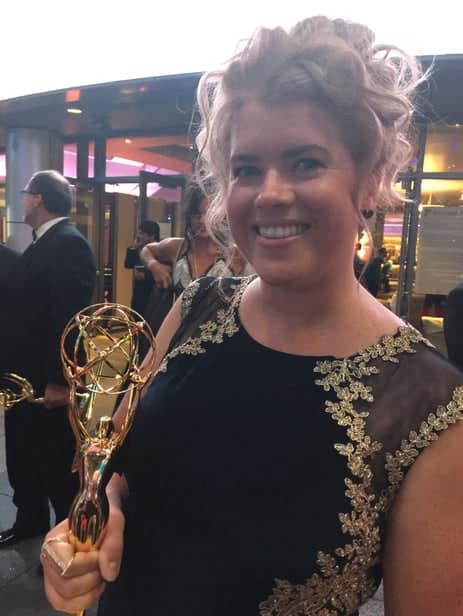Alumni Awarded Emmy for VFX Work on 'Gotham'
While the “Lead Actor, Comedy” or “Best Drama Series” awards get much of the attention, Emmy Awards recognize excellence in all facets of television, even aspects that often go unnoticed by fans. Visual effects (VFX), sound editing and more are integral elements of storytelling, but many VFX artists especially—according to Academy alumna Ryan Bauer—trust a general rule: “Good visual effects are often when you don’t know they are visual effects.”

The Emmy judges definitely knew when to take note, which is why they awarded Bauer, fellow Academy alumnus Alex Gitler and their employer CoSA VFX’s team the “Outstanding Special Visual Effects in a Support Role” trophy for their work on Gotham. The VFX crew won specifically for their work on the season three episode “Heavydirtysoul,” which Bauer believes stood out because of the diversity of the work presented, including “set extensions or makeup fixes” but also “very specialized, well-developed effects.”
“Scope is one way we stood out, and doing the volume and breadth of those shots to a great level is what clinched it for us,” she explains. “The visual effects we did for Gotham supported the narrative in a lot of different ways, not solely to create the environment, but also to help tell the story.”
Gotham was chosen over The Crown, Genius, The Handmaid’s Tale and Taboo. CoSA also won the “Outstanding Special Visual Effects” Emmy for participation in Westworld, although Gitler and Bauer were not accredited for that win. Most shows commission multiple VFX teams for a series—or even a single episode—but as the singular vendor for Gotham, Bauer says, “[It was] really unique for us to be a part of that from page to screen, full-process.”

“As sole vendor in that show, we are in every aspect of the process of the VFX work,” Gitler adds. “That goes from the concept talk based on the script in the initial stages, making sure that shots and instances that have [the required] VFX work in them. We have a say and input so they can be done to the best of our abilities for our client.”
CoSA VFX has also worked on shows such as Marvel’s Agents of S.H.I.E.L.D., Person of Interest and Roadies…and continues to grow. According to Gitler, CoSA is considered a medium-sized company in the industry, employing around 140 people, a considerable growth spurt from its starting roster of just four people operating out of a garage in 2011.
“That kind of growth is a testament to where we’re at,” Gitler says, “growing quickly and taking on bigger and better projects.”
Gitler, born in Israel, graduated from the Academy in 2004 with an MFA in Computer Arts with emphasis in 3D Visual Effects. After graduation, he did animation, commercial and gaming work before switching to feature films in 2006. He was hired at CoSA in 2015. “As a supervisor in a company like CoSA, you do get to have a lot more of seeing the process in the pipeline and as the company grows, you grow with it,” he says.
Bauer, a 2012 MFA graduate in Animation & Visual Effects, initially majored in theater. Next she worked as a compositor for a number of studios, earning credits for titles such as Pacific Rim, Captain America: The Winter Soldier, Mad Max: Fury Road and Thor 2: The Dark World. She started at CoSA on a contract, then was plugged-in full time.
“I was really excited about the opportunity,” she says. “The size of the company is appealing to me…each person isn’t just a small part of a huge machine. I felt like I could really form a second family here.”
Both Gitler and Bauer say their time at the Academy was crucial to learning how to be a professional in pursuit of an animation career within a highly competitive industry. Bauer says Animation & Visual Effects instructor Catherine Tate’s compositing collaborative—known as Studio X—was instrumental in learning how to collaborate using real footage from real clients.
“[The class] was pretty invaluable in getting a taste of what a studio pipeline would be and having people you’re beholden to and a team you work with,” she recalls. “And it’s not working in a vacuum in your dorm or apartment, projects only you and your instructor might see. Having that kind of exposure early on was really unique and special.”
For Gitler, these types of hands-on, real-world scenarios wouldn’t be possible without the high-caliber instructors the Academy brings in to teach its students.
“Getting to see how industry professionals work and how they think is much better than someone just teaching you how to push a button to get something to work,” he reflects. “At the end of the day, you really want inspiration out of the people you work with to want to be better and learn new things, and I think that starts at school. If you have teachers and department heads that inspire you to go further and do better, then you will.”
“School is not only a place to learn how to do the art but it’s also learning what to expect once you get into the industry,” Bauer adds. “Having people who have been in the industry as your instructors is crucial so that you know how to not only be good at your art, but make yourself a useful employee that companies will want to bring back time and time again. Not just because you’re good, but because you’re a great teammate and a good collaborator.”